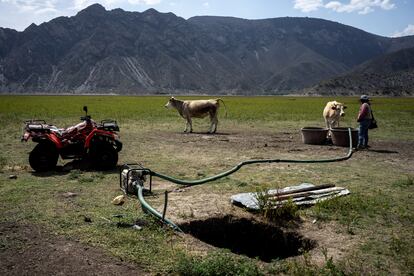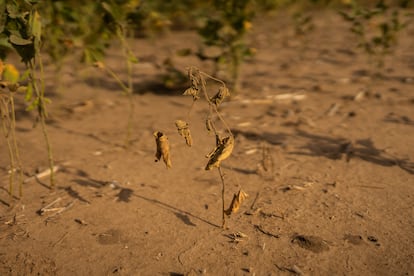Latin America loses 22% of its fertile land, the equivalent of three Colombias
According to data from the United Nations Convention to Combat Desertification, more than 70% of Mexico’s surface area has been affected. Countries like the Dominican Republic, however, are showing signs of recovery


Latin America and the Caribbean are losing land. Due to an extreme mix of land degradation, drought and climate change, the region has become one of the areas in the world where the most healthy and productive lands are being affected annually, according to data compiled by the United Nations Convention to Combat Desertification (UNCCD), which includes information provided by 126 countries up until 2022.
“We’re a continent that still has an extractive economy, that doesn’t recognize the value of nature and the ecosystem services it provides us, a region in which there are no economic or negative consequences for affecting the soil,” laments Costa Rican Andrea Meza, deputy executive secretary of the UNCCD.
Overall, in 2019 — and only taking into account the countries that report this type of information to the UNCCD — 378 million hectares were degraded in Latin America and the Caribbean, a proportion that is approximately equivalent to three times the size of Colombia, which represents 22% of the region’s land. Meanwhile, drought affected 377 million hectares between 2016 and 2019 alone, with the most acute peak taking place in 2017.
Among the countries that have reported data to the UNCCD, Mexico is a particularly critical case. With 139 million hectares degraded by 2019, 72% of its surface area has already been affected by this phenomenon. Regarding drought, the UNCCD data panel indicates that up to 115 million hectares of Mexican land were affected between 2016 and 2019.
The data from the region exceeds the global average, since the degradation reported by the 126 countries that shared their information reaches 1.5 billion hectares and is equivalent to 15% of the world’s surface area. If the necessary measures aren’t taken, it’s estimated that this land loss could increase by 4% every four years globally, affecting more than 1.8 billion people due to droughts alone.
In Latin America, there are currently around 539 million people (41% of the reported population in 18 countries) who have been impacted by land degradation. Regarding the drought — on which the UNCCD has information from 20 countries in the region — it’s estimated that 196 million people have been affected.
As Meza from the UNCCD explains, drought and land degradation are two phenomena that go hand-in-hand and lead to desertification, a process in which the land loses its fertility and becomes more arid. This affects not only biodiversity, but also the ability to produce food. “When we experience drought, it’s not only because of the lack of rain, but because — when there’s degraded land — our vulnerability increases. In other words, if we had healthy lands, in periods of little rain or low drought, we would have greater resilience.”

The Dominican Republic, a case study
If one navigates the data dashboard that the UNCCD has created to compile this information, one can closely examine the realities of countries that have reported to the Convention. With 1.49 million hectares degraded (31% of its surface area) and 4.65 million hectares that have been affected by drought (96%), the Dominican Republic could declare itself in crisis.
However, according to Meza, if we look at what was happening there in 2015, we would realize that the land degradation declined from 49% to 31%. The country began working on an ambitious soil recovery goal and, in fact, is working to restore 240,000 hectares in the Yaque del Norte river basin, as well as in cocoa production areas in the province of San Francisco de Macorís.
“There are several countries that are giving good signs through public policies that should be followed,” the expert adds. “This involves understanding the land management and understanding that nature must be allowed to continue functioning, either through consolidating biological corridors, or by applying mixed agricultural systems, such as silvopasture [the practice of integrating trees and grazing] or agroforestry.”
The Amazon and the Southern Cone: other critical regions
Beyond just one country, Meza clarifies, Latin America has huge areas that are critical to drought and degradation. Of course, there’s the risk of losing the Amazon — a region framed by nine countries — which is currently going through one of its worst droughts. At all costs, the Amazon rainforest must be prevented from reaching a point of no return. “But there’s also a drought in the Southern Cone, which has had an impact on the GDP in Argentina, Paraguay and Uruguay. And a mega-drought has affected countries like Chile.”
If one goes to the data reported by Chile and compiled by the UNCCD, it’s estimated that only around 6.44% of the reported area has been degraded, which is equivalent to 4.6 million hectares. However, if the data for droughts is taken into account, the phenomenon is far larger, having had an impact in 66% of reported areas — the equivalent to almost 50 million hectares.
Sign up for our weekly newsletter to get more English-language news coverage from EL PAÍS USA Edition
Tu suscripción se está usando en otro dispositivo
¿Quieres añadir otro usuario a tu suscripción?
Si continúas leyendo en este dispositivo, no se podrá leer en el otro.
FlechaTu suscripción se está usando en otro dispositivo y solo puedes acceder a EL PAÍS desde un dispositivo a la vez.
Si quieres compartir tu cuenta, cambia tu suscripción a la modalidad Premium, así podrás añadir otro usuario. Cada uno accederá con su propia cuenta de email, lo que os permitirá personalizar vuestra experiencia en EL PAÍS.
¿Tienes una suscripción de empresa? Accede aquí para contratar más cuentas.
En el caso de no saber quién está usando tu cuenta, te recomendamos cambiar tu contraseña aquí.
Si decides continuar compartiendo tu cuenta, este mensaje se mostrará en tu dispositivo y en el de la otra persona que está usando tu cuenta de forma indefinida, afectando a tu experiencia de lectura. Puedes consultar aquí los términos y condiciones de la suscripción digital.
Archived In
Últimas noticias
Most viewed
- Sinaloa Cartel war is taking its toll on Los Chapitos
- Oona Chaplin: ‘I told James Cameron that I was living in a treehouse and starting a permaculture project with a friend’
- Reinhard Genzel, Nobel laureate in physics: ‘One-minute videos will never give you the truth’
- Why the price of coffee has skyrocketed: from Brazilian plantations to specialty coffee houses
- Silver prices are going crazy: This is what’s fueling the rally








































